Noticing stains, cracks, low spots or crumbling in your grout? You might be adding too much water to your mix. Read our seven simple tricks to avoid overwatering Flowpoint grout that will improve the finished job and help you avoid efflorescence. Includes an expert tip on quickly getting rid of standing water if it arises.
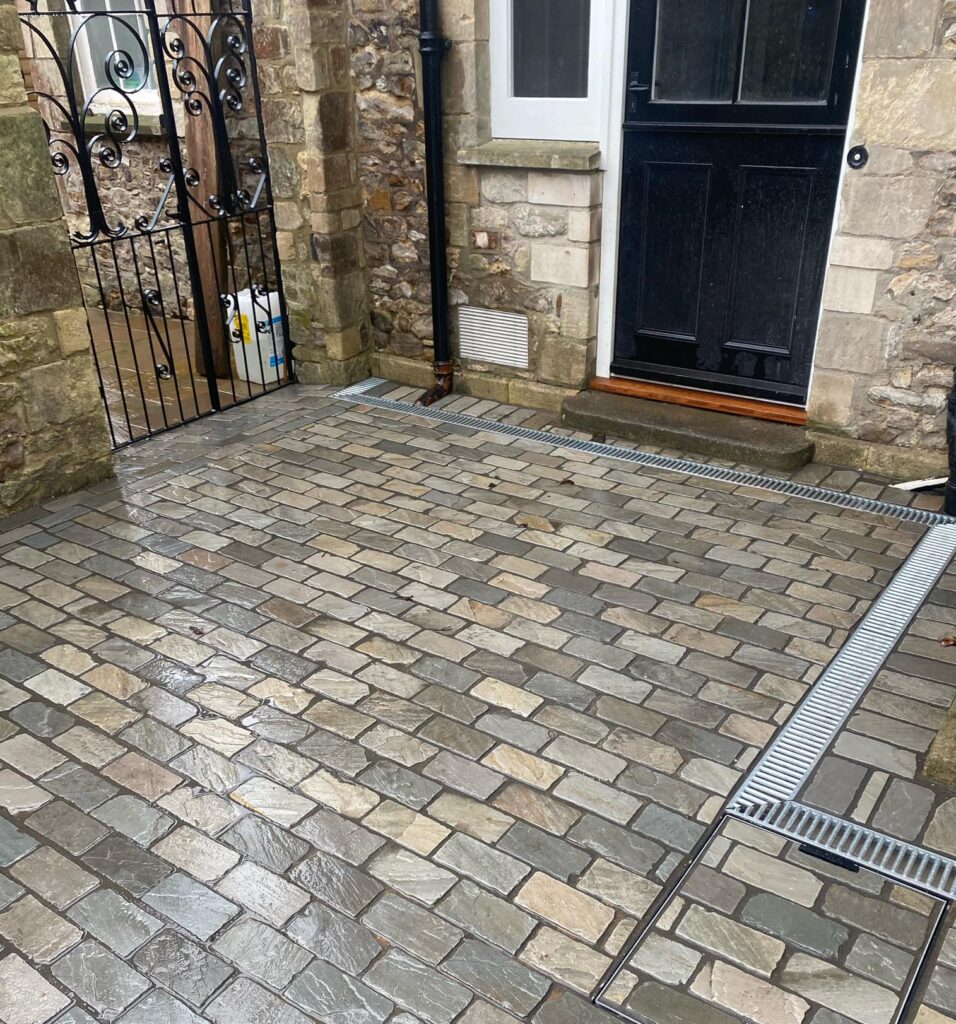
Why does overwatering cause problems?
When mixing Flowpoint paving grout you need to add the right amount of water to the cement-based mix.
Simply put, if you add too much water during the mixing process, you risk compromising the cementitious formula.
With too much water in the mix, there is greater risk of issues, such as efflorescence and low spots on paving surfaces. Once dried, the grout can even start to crumble.
Likewise, adding not enough water can also cause issues, so it’s best to follow the manufacturer instructions on quantities.
Adding the exact amount of water allows you to create a mix with perfect fluidity so you can fill paving joints neatly and with ease. When the mixed product has the correct balance of water to powder to ‘go off’ or set, the strength of the mortar will not be adversely affected.
Overwatering Flowpoint during application is another common issue. Although the area needs to be kept damp during application, pooled water on slab surfaces and within joints is something to avoid.
Not that you should ever be put-off about using a cement-based slurry grout. In actual fact, Flowpoint is one of the market-leading slurry grouts (specifiers and architects request it by name on major projects in our towns and cities). It’s also a hugely popular grout chosen by thousands of smaller contractors on domestic patio projects across the country.
All it takes is a little extra knowledge to get you pointing pavers and patios quickly and efficiently.
Why does Flowpoint get overwatered?
Unwarranted concerns about using a cement-based slurry
One of the biggest reasons why some contractors overwater Flowpoint is their concerns about pouring a cement-based formula onto their pristine pavers.
Armed with these concerns, some people add more water to ensure the mix doesn’t set too quickly.
Head Trainer at the Landscaping Academy, Gareth Wilson, acknowledges why it’s common to be “quite rightly scared” when it comes to using a slurry grout for the first time.
“I don’t care who you are or how good you are, if you don’t have a little bit of anxiety about pouring cementitious slurry onto the surface of your slabs, then you’re telling a few porkie pies,” says Gareth, who is also a landscaping expert witness.
But as a rapid-setting grout, Flowpoint has been specially developed so it doesn’t stick to the paving surfaces. And it comes complete with the British Standard seal of approval of BS 7533.
“When you first use Flowpoint, it might feel that it goes against everything you’ve been taught and should do,” Gareth explains.
He adds that after watching a demo, and with a little careful timing, you’ll be away using Flowpoint yourself.
“Once you’ve seen it done, you can see that it’s dead easy to use and install. All you need is a little bit of training and a little bit of know-how.”
And one of those know-hows is knowing how much water to use when keeping the area damp. Read on to find out exactly how much water to add to your pavers and when.
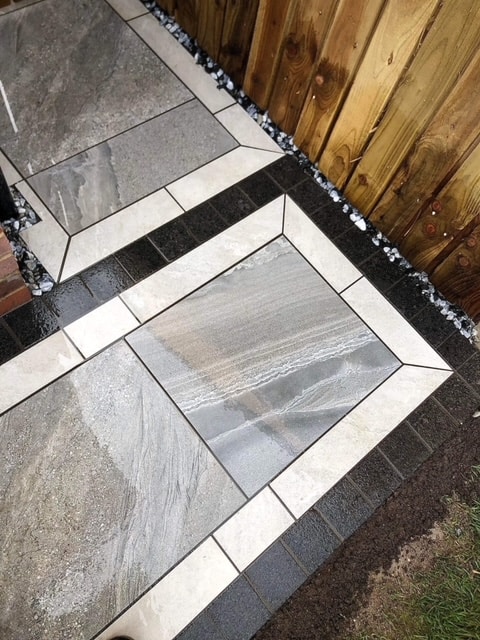
Jointing during hot weather
There’s another reason why some contractors overwater Flowpoint: when the slurry grout is applied during hot weather.
As with all cement-based grouts and mortars, the curing time speeds up rapidly when the outdoor temperature is 20ºC and over.
Cleo Canning of The Paving Experts explains, “Flowpoint is tested at 20 degrees so at this optimum temperature it should set as per the datasheet.
“Issues can occur when the temperature is over 20 degrees, especially when it is rising above 25 degrees. During these temps it can set really quickly at circa 15 minutes so contractors need to be on it and keep the area misted.”
When a more traditional grouting formula, such as a three-to-one mortar mix, sets faster than you can physically manipulate the mortar into the joints, many paving contractors have been taught to add a little more water to the mix to stop it from setting too fast.
But you should never add extra water to Flowpoint. Only ever add the stipulated amount of water on the packaging, which is 4.25 litres of water to a bag of formula and 3.4 litres of water to a tub.
Gareth emphasises, “Basically, you don’t use Flowpoint when the temperature is too high.
“When the temperature is approaching 30 degrees, just don’t bother. Or if you’re desperate to get the job finished, do it at 6 o’clock in the morning instead.”
Let’s move on to the essential tricks to avoid overwatering Flowpoint so you have a fantastic-looking paving job each and every time.
Simple tricks to avoid overwatering Flowpoint
Use these insider tips to ensure a professional finish on every job with Flowpoint. These simple hacks can also be used for other cement-based slurry grouts such as Fuga Pave.
Following our tips will help you avoid any nasty surprises like dried-on grout and efflorescence.
#1 Mix the right amount of water
Forget the Jamie Oliver approach to guesstimating ingredient quantities. With Flowpoint – and all other slurry grouts – you need to be exact with how much water you add to the mix. In fact, it’s always wise to follow the manufacturer’s instructions and add the specified amount of water.
Follow the advice on the Flowpoint bag, or tub if you’re using Flowpoint Fine.
A final note on mixing that you likely covered in Landscaping 101 (but just for those novices): always add the water first, followed by the grout formula before mixing.
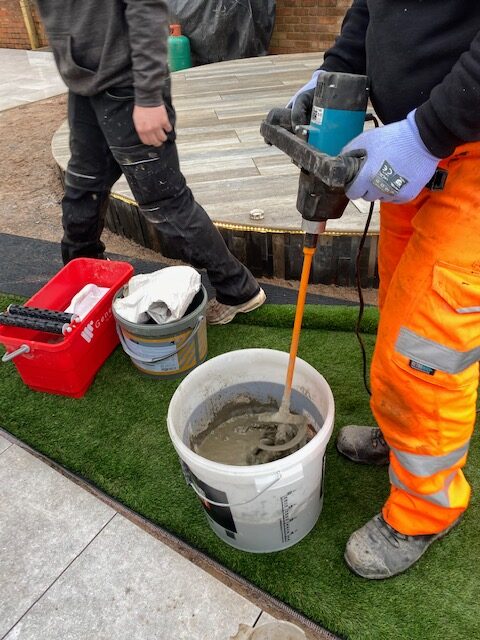
#2 Never grout during hot weather
When using a slurry grout, there is one time when you have absolute authority to down all tools and go home for the day (or even treat your team to a pint at the pub!). That’s when the outdoor temperature is 30ºC or over.
Seriously though, applying a cement-based slurry grout during high temps is an absolute no-no.
But there are other options, especially considering Flowpoint was used to pave 9,000m2 outside the Dubai Opera House.
If we’re lucky enough to be in a heatwave here in the UK, you have two options:
Either move your grouting operations to a cooler day.
Or, alternatively, rise before dawn to make use of the cooler temperatures first-thing in the morning.
For those night owls among us, you can always try the late afternoon or early evening. But bear in mind that even if the ambient temperature is around 25ºC, the pavers have had the entire day to soak-up and store the heat so they will be a few degrees hotter.
Flowpoint can start to set within 15 minutes when the temperature is 20ºC. So even during the twenties, you may want to consider being an early riser or (very) late starter.
That said, there are many things you can do to improve the workability and setting time of Flowpoint to your advantage.
Read the article on 10 tricks for slurry grouting during warmer weather.

#3 Pre-soak pavers with a light misting
No matter what the weather, it’s always essential to pre-soak pavers before grouting.
Cleo explains, “One of the biggest causes of pointing failure is extremely porous paving flags sucking the essential moisture out of the pointing mortar before it has a chance to set properly.
“Giving the pavers a good blast of water a few hours before means that when the slurry is laid, the flags won’t suck additional water from the slurry grout which can then lead to weak grout that is more likely to crack or fail.”
Also, if the day is warm, the hotter-than-usual slabs are likely to absorb a small amount of water from the ready-mixed grout. That in itself can cause havoc for the slurry formula.
By lightly misting paving slabs (before mixing and applying the grout) you’ll ensure the pavers are wet enough to reduce any water absorption from the grout mix.
An extra word of warning: when we say a light mist, we mean a light mist.
If pools of water are appearing on paving surfaces and within joints, then stop the misting: you’re saturating the area instead, which will compromise the quality formula (and risk efflorescence).
“The trick is to get the slabs damp enough without creating puddles on the slab surfaces or within the joints,” adds Cleo.
Read on to find out how to quickly deal with standing water (spoiler alert: you just need someone with a leaf blower on standby).
#4 Keep the area constantly damp
There’s a massive difference between ‘damp’ and ‘wet’.
‘Damp’ means the surfaces of the joints are ever-so-slightly wet to touch.
‘Wet’ is when you can see water pooling on the surfaces and within the paving joints.
Always keep the area damp during application to prevent slurry grouts from sticking to the pavers.
We recommend using a light misting of water from a hosepipe with a spray nozzle, or with a plant mister. It’s a good idea to have a team member on-hand with the hose while someone else is manoeuvring the grout into the required joints (more on that in a moment).
And speaking of rain during application. A light shower is not a problem while applying Flowpoint, but a downpour is best avoided. See our full article on whether it’s a good idea to apply Flowpoint in the rain.
#5 Quickly remove any pooled water
It happens. Either the ‘water guy’ gets distracted or there’s a sudden downpour that means you have saturated pavers and joints to deal with.
Gareth and his team always have a leaf blower on hand to remedy any pooled or standing water:
“My lads will use a leaf blower to blow all of the moisture and debris out of the joints,” he explains.
“They get the joints all nice and clean and make sure they contain no standing water before applying Flowpoint.”
Why is avoiding pooled water so important?
Standing water will add additional water into the grout mix and can potentially cause stains or low spots. It can even cause the grout to crumble once fully dried.
#6 Ensure the joints are touch dry
Before we move on to the best ways to clean-off Flowpoint, we need to cover when is the time to clean-off the slurry grout.
Choosing the right time to clean-off grout really depends on the outdoor temperature. It could be 15 minutes during warmer temperatures. It could be 30 minutes or longer when it’s cold.
Without obsessing over thermometers, there’s one simple solution to this conundrum.
You need to ensure the mortar is touch-dry in the joints.
After years of using Flowpoint himself, Gareth recommends doing a thumb test.
The thumb test involves lightly touching the filled joints with your thumb and checking whether an imprint is left behind. No thumbprint and the grout has properly set.
Nick Holmes, Lead Trainer at Instarmac, explains that another way of understanding whether it’s time for the clean-off stage is when the product ‘stops bleeding’ from the joints.
“Flowpoint should be set in the joint but not on the surfaces,” advises Nick.
“Keep it agitated and damp on the slab with regular light mistings of water. As soon as the joint is firm enough to repel the water, you can power wash or increase water flow.”
Once the slurry grout is repelling water, do two passes: one light pass with water to agitate the mortar on the surface of the slabs and remove any stubborn grout. Then, follow it with a second washdown to remove the last of the grout.
Next we’ll cover the easiest and most efficient equipment to use for cleaning off Flowpoint to avoiding overwatering.
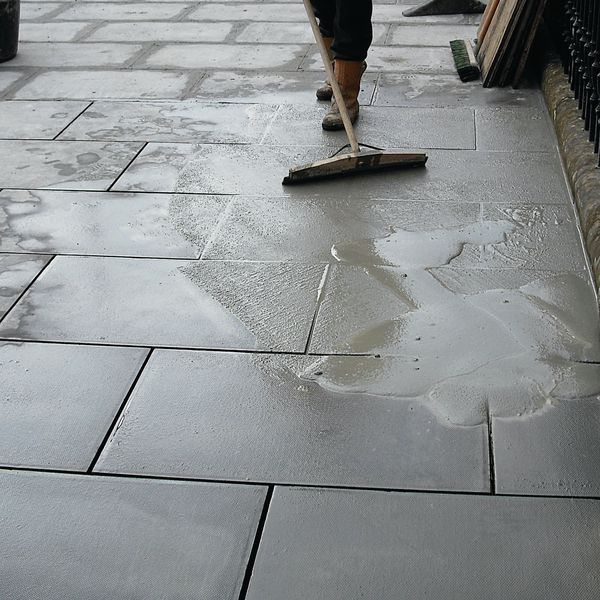
#7 Use the right equipment for clean-off
Last but no means least, we’re at our final trick to avoid overwatering Flowpoint.
That final trick is to use the right equipment for clean-off.
You have a few options when it comes to cleaning off slurry grouts.
You can manually use the long-handled Neoprene squeegee and a power washer to agitate the surfaces and remove as much of the grout as possible off the slabs.
Although using a Neoprene is still much easier than the alternative to slurry grouting (the traditional three-to-one mortar mix), it’s not nearly as time-saving as a Berta.
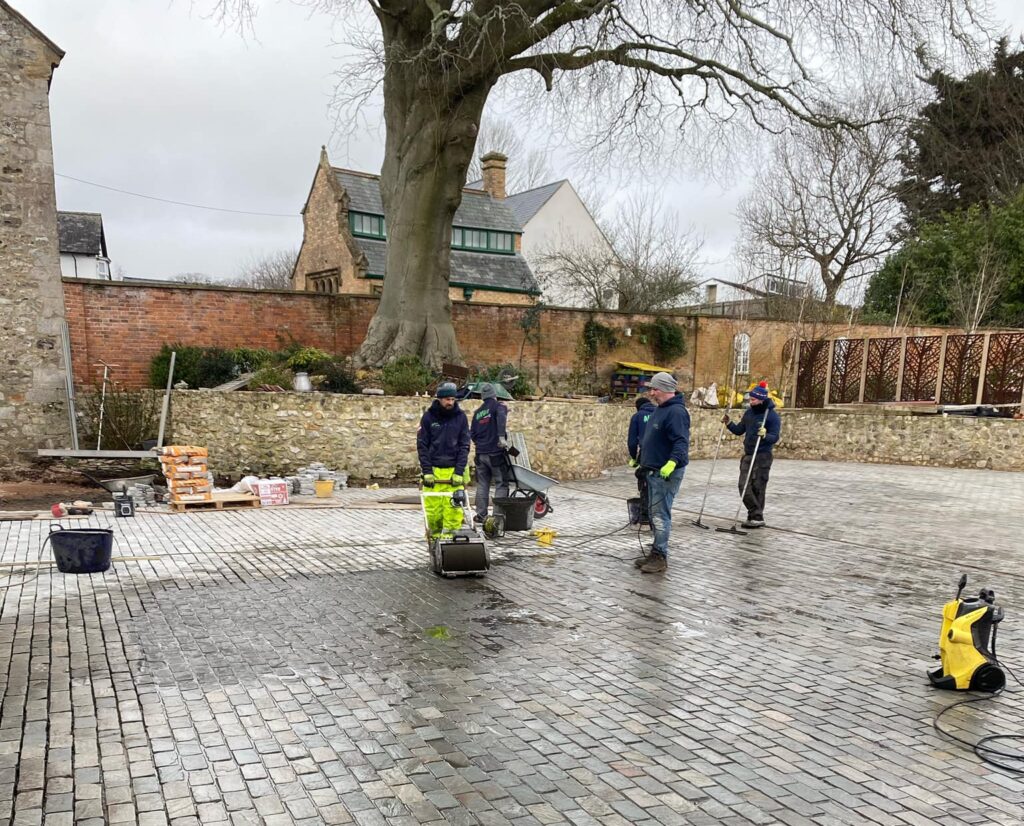
Especially recommended if you’re working on a larger area, the Berta ADV Sponge Machine cleans off Flowpoint so efficiently and effectively that it pretty much prevents staining from happening.
If you’re not ready to to invest in a Berta (they are also available to rent), the Pedalo Washboy is another great option as it allows you to rinse-off as much of the excess grout as needed using the pedalo bucket.
New to slurry grouts? Drop us a line
If you haven’t yet taken the jump into using a slurry grout like Flowpoint, Larsen FJM or Fuga Pave, we’re sure you’ll love the results you achieve on your projects.
Not only that, slurry grouts completely slash your application times AND they can save valuable cash too as they tend to be between 50% and 75% cheaper than resin-based or specialist epoxy grouts (which can be £115 per 20kg tub).
Slurry grouts really are an easy product to use once you know how. Another major plus is they’ll reduce your team’s complaints about sore backs as there will be no more slow-progress-pointing on hands and knees.
If you want to find out more about slurry grouts like Flowpoint, give us a call on 0330 122 1025 and we can talk you through the product. We also have plenty of Flowpoint advice and videos online if you prefer to browse through those first.
We can even put you in touch with the team at Instarmac to arrange a demo for your gang, just like the Flowpoint demo for landscapers in Cardiff that happened earlier in the year.
Got any further tips for using Flowpoint or other cement-based grouts and mortars? Share them in the comments box below.

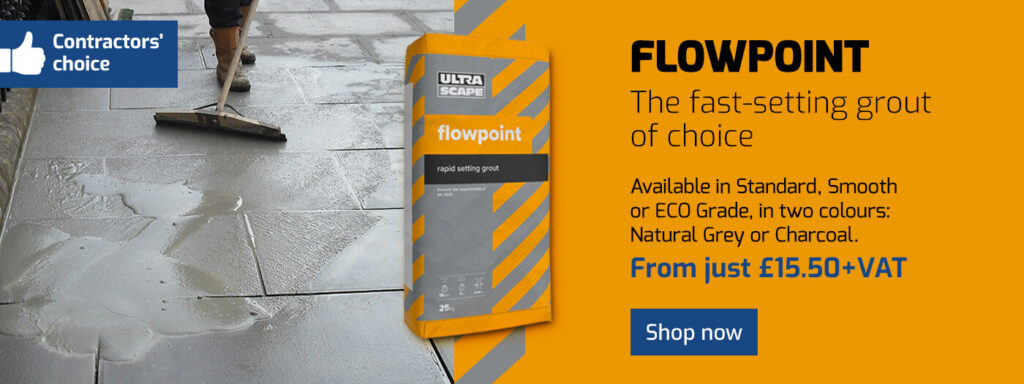
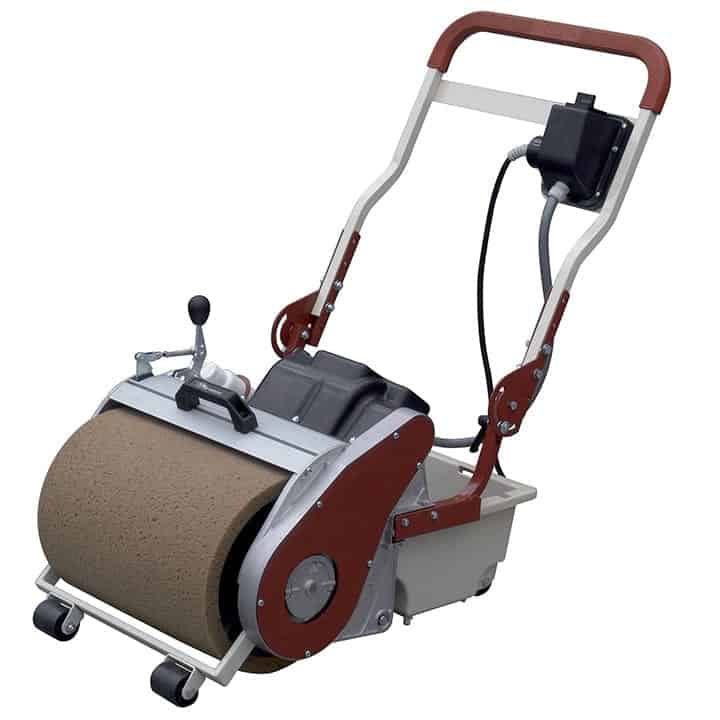


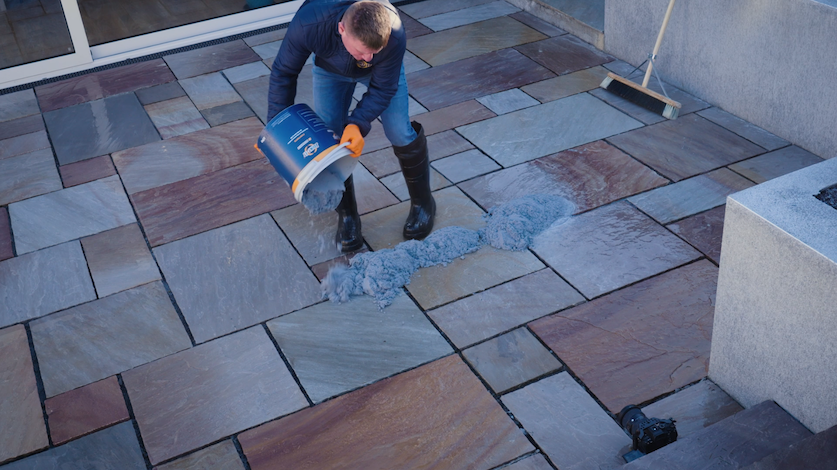
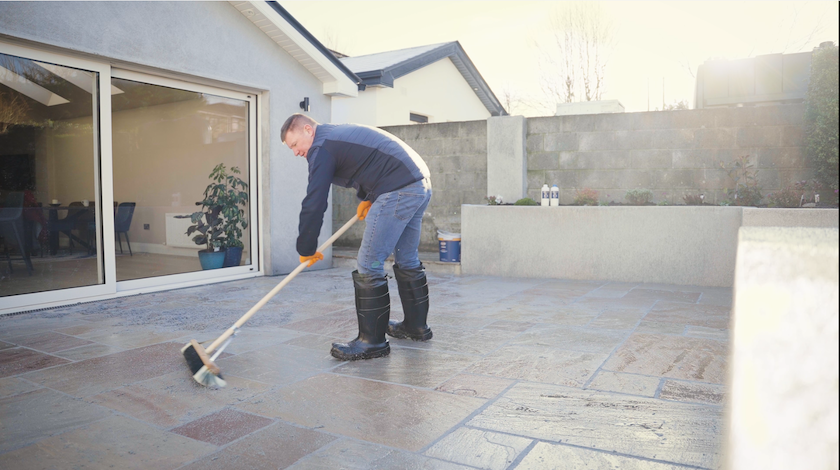


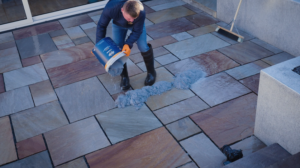

4 thoughts on “7 simple tricks to avoid overwatering Flowpoint grout”
Hi been asked by a customer to repair flowpoint that was applied when it was too hot and then had a too much water added by the looks of it – some areas have sunk, dark patches and gaps between the flowpoint and tiles.
Any advice on how to remove existing flowpoint, so I can replace with new?
Regards
Simon
Hello Simon, you could try Lithofin to start, but you may need to grind the Flowpoint out of the joints and use a scabbling tool to take it off the surface of the slabs. However – unfortunately when Flowpoint is applied in hot weather it can stick, if it isn’t kept misted with a small amount of water at all times. I’d try some Lithofin and test an area 1st. Any advice you need please feel free to give us a call on 0330 122 1025. Regards, Cleo.
Hi, I have been asked to repair a patio where too much water has been added to the flow point mix so the joints have popped in a couple of areas after deep frost. How would you recommend removing the grout from the joints? Thanks.
Hi Ollie, I’m afraid it will take a good old-fashioned angle grinder and elbow grease to remove the grout. Give us a call if you’re unsure and want to discuss.